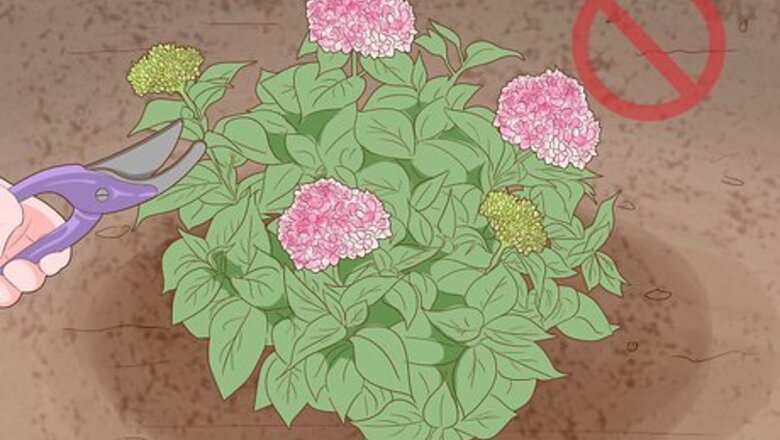
views
Prune at the right time of year.
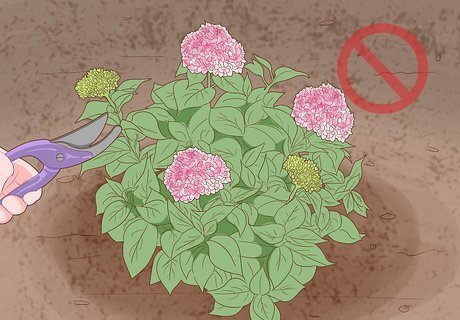
Double-check that you didn't prune away the flower buds. Many hydrangeas bud from old wood, so to get flowers you'll need to keep the stems intact over winter. These species are Hydrangea macrophylla (bigleaf, mophead, lacecap, or mountain, with 4in/10cm+ leaves); H. quercifolia (oakleaf, with oak-like leaves); and H. anomala (petiolaris) (the climbing hydrangea vine). You can safely prune these in late summer, right after the flowers fade and strong shoots form. Remove no more than the top ⅓. Climbing hydrangeas bloom mostly from the top, so prune cautiously. Other hydrangeas flower on new growth: feel free to prune back H. aborescens (smooth or wild hydrangea) or H. paniculata (grandiflora) in late winter or early spring.
Give hydrangeas enough sun.
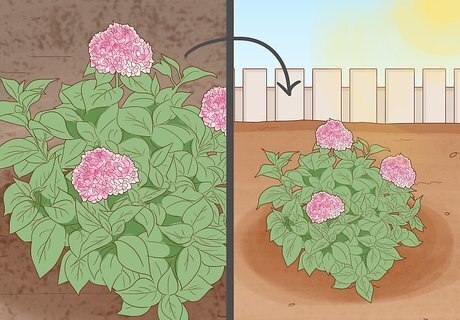
Transplanting to an area with enough sun may help with flowering. This is particularly true of bigleaf hydrangeas, but even easier-blooming species need sun. Transplanting is best done when the plant is dormant in the fall or spring, or winter in regions without frozen ground. Different sun levels are suited to different species: Full sun to partial shade: H. quercifolia, H. paniculata Partial shade: H. macrophylla, H. aborescens. An area with morning sun and afternoon shade is ideal. If full sun is unavoidable, keep the soil consistently moist. Partial shade to full shade: H. anomala
Prolong blooms with sun protection later in the season.
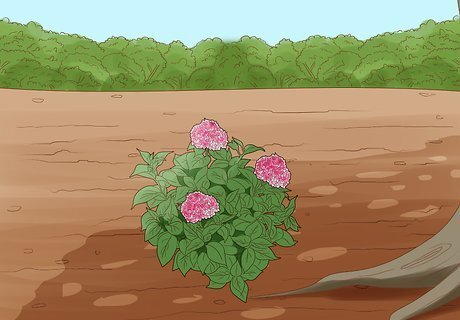
Partial shade after blooms appear may protect the flowers. Some hydrangea varieties have much longer-lasting blooms in partial shade, fading slowly to purple or green instead of a quick brown fade in full sun. So even though sun is needed to get your plants to flower, putting up a patio umbrella or sun shade in the afternoons once the flowers appear could be a worthwhile experiment.
Protect hydrangeas over winter.
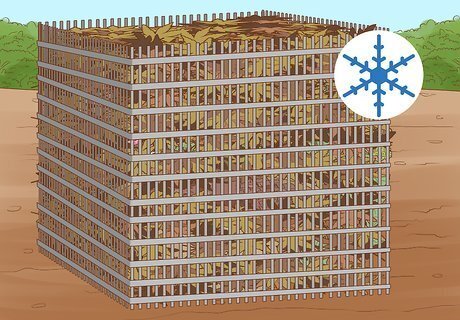
Protect old wood hydrangeas over winter to save flower buds. The bigleaf and oakleaf hydrangeas (H. macrophylla and quercifolia) can lose their buds to winter damage. To protect against harsh winters, build a chicken wire enclosure around the hydrangea plant. Fill it loosely with shredded leaves to a depth of 10–12" (25–30cm). Most buds die below -10ºF (-23ºC) without protection. H. macrophylla is temperamental and can also lose blooms to sudden temperature changes. Other species are either winter-hardy or do not have winter buds.
Protect against spring frosts.
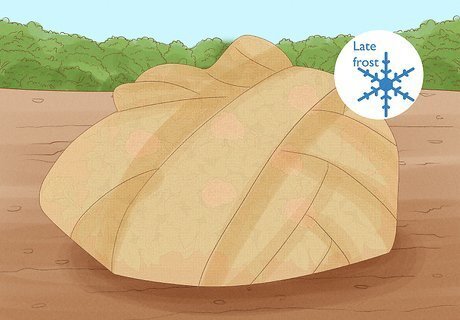
Throw on an insulating cover for late frosts. After protecting your hydrangea all winter, it would be a shame for the last frost to destroy your dreams of flowers. If the temperature drops after you've taken off the winter cage, cover the plant with cloth, burlap, or heavy paper. Avoid plastic, which can damage the plant. As with winter damage, this only applies to H. macrophylla and H. quercifolia. Other species can survive and flower after all but the most extreme winter conditions.
Avoid over-fertilizing.
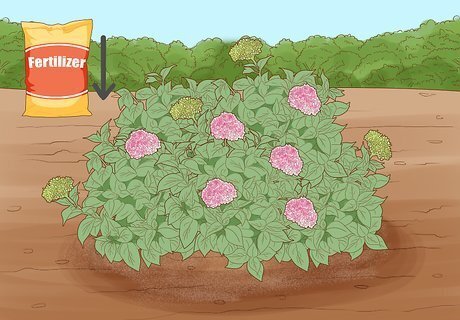
Reduce fertilizer if blooms are poor. If you're getting a wonderful green explosion with hardly any blossoms, you may have added too much nitrogen to the soil (in the form of compost or commercial fertilizer). In many cases, adding no fertilizer at all will give better results. If your soil is poor or the plants are struggling, use slow-release fertilizer a couple of times during the growing season. One exception: if, while blooms are growing, the central leaves begin to yellow, throw in some fast-acting fertilizer.
Water frequently.

Hydrangeas do best in soil that stays moist, but not soggy. Most hydrangeas love it when you soak their soil regularly. Keep the soil loose and wet to the touch pretty much all the time. Give hydrangeas in full sun much more water than ones in partial shade, and even more if their leaves start to droop. Poor-draining soil can rot your plants' roots. If a 1 ft × 1 ft (0.30 m × 0.30 m) test hole filled with water doesn't drain within 15 minutes, try amending the soil with compost, peat moss, or similar, or build a raised planting bed filled with loamy soil. If clayey soil can't be helped, make sure to water less.
Preserve moisture with mulch in dry conditions.

Spread a 3 in (7.6 cm) layer of mulch in summer. For hydrangeas, mulch is mostly important for trapping moisture. If hot, dry weather is expected, add organic mulch to the soil before each hydrangea begins blooming. Keep the mulch about 3 in (7.6 cm) from the stems to prevent them from rotting. If you have alkaline soil, try pine needles or bark as a mulch. These make the soil a little more acidic, which hydrangeas prefer. Mulch is often used to insulate roots over winter as well, but unfortunately, it is not likely to save the flower buds on hydrangeas (for old wood blooming varieties).
Change blossom color with soil additives.
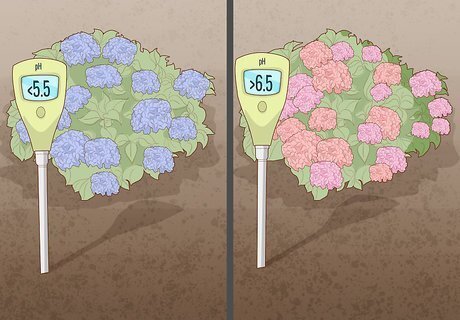
Some big leaf varieties can bloom blue or pink depending on the soil. Soil acidity can affect the flower color, but although hydrangeas slightly prefer acidic soil, this is unlikely to be a big factor in whether it blooms at all. But if you do succeed in getting your H. macrophylla to bloom, you can try a science experiment to change its flower color from year to year: Test a sample of soil pH with a kit from a gardening center. A pH below 5.5 encourages blue blossoms. Lower the pH with compost, coffee grounds, or other organic materials, or using sulfur soil amendments from a garden store. A pH above 6.5 encourages pink flowers. Raise the pH by adding wood ash, lime, or some high-pH fertilizers. If your soil is acidic but your flowers aren't blue, you might need to add aluminum sulfate to the soil.
Treat fungal diseases.
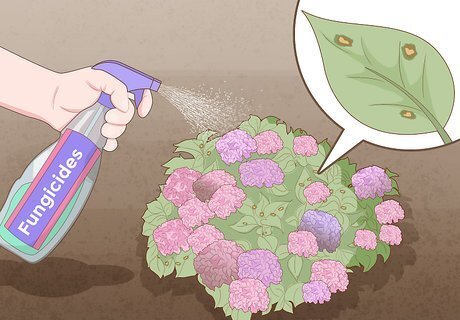
Disease is not a common cause of flower issues, but check for severe damage. Hydrangeas are fairly disease-resistant in most areas, but a severe fungal infection could damage it enough to interrupt flowering. Look for unusual colored spots on the leaves and flowers. Treat green, yellow, or brown spots with a fungicide. Ask the staff at a gardening center for advice on local fungus identification and products. Powdery mildew and black spots are signs that your hydrangea is getting too much shade and not enough air circulation. Consider transplanting. Many fungi come from excess moisture. Watering in the morning so the plant dries faster can help. If you aren’t able to treat a disease, get rid of the infected plant as soon as possible to prevent the disease from spreading. Dead or dying plants that look badly discolored often aren’t salvageable and can ruin any other hydrangeas you have.




















Comments
0 comment